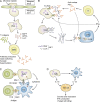Diverse novel functions of neutrophils in immunity, inflammation, and beyond
- PMID: 23825232
- PMCID: PMC3698517
- DOI: 10.1084/jem.20122220
Diverse novel functions of neutrophils in immunity, inflammation, and beyond
Abstract
Neutrophils have long been considered simple suicide killers at the bottom of the hierarchy of the immune response. That view began to change 10-20 yr ago, when the sophisticated mechanisms behind how neutrophils locate and eliminate pathogens and regulate immunity and inflammation were discovered. The last few years witnessed a new wave of discoveries about additional novel and unexpected functions of these cells. Neutrophils have been proposed to participate in protection against intracellular pathogens such as viruses and mycobacteria. They have been shown to intimately shape the adaptive immune response at various levels, including marginal zone B cells, plasmacytoid dendritic cells and T cell populations, and even to control NK cell homeostasis. Neutrophils have been shown to mediate an alternative pathway of systemic anaphylaxis and to participate in allergic skin reactions. Finally, neutrophils were found to be involved in physiological and pathological processes beyond the immune system, such as diabetes, atherosclerosis, and thrombus formation. Many of those functions appear to be related to their unique ability to release neutrophil extracellular traps even in the absence of pathogens. This review summarizes those novel findings on versatile functions of neutrophils and how they change our view of neutrophil biology in health and disease.
Figures



References
-
- Abadie V., Badell E., Douillard P., Ensergueix D., Leenen P.J., Tanguy M., Fiette L., Saeland S., Gicquel B., Winter N. 2005. Neutrophils rapidly migrate via lymphatics after Mycobacterium bovis BCG intradermal vaccination and shuttle live bacilli to the draining lymph nodes. Blood. 106:1843–1850 10.1182/blood-2005-03-1281 - DOI - PubMed
Publication types
MeSH terms
Grants and funding
LinkOut - more resources
Full Text Sources
Other Literature Sources
Medical

